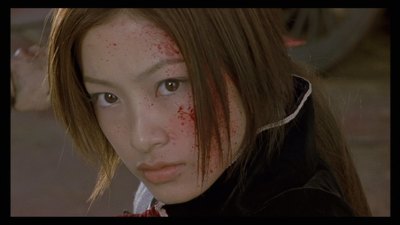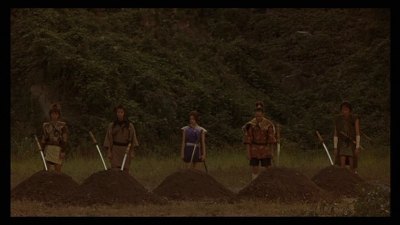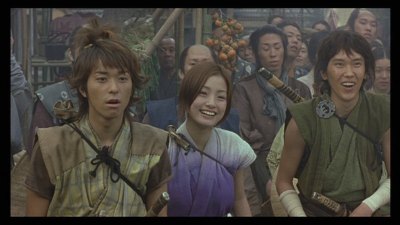| Reviews & Columns |
|
Reviews DVD TV on DVD Blu-ray 4K UHD International DVDs In Theaters Reviews by Studio Video Games Features Collector Series DVDs Easter Egg Database Interviews DVD Talk Radio Feature Articles Columns Anime Talk DVD Savant Horror DVDs The M.O.D. Squad Art House HD Talk Silent DVD
|
DVD Talk Forum |
|
|
| Resources |
|
DVD Price Search Customer Service #'s RCE Info Links |
|
Columns
|
|
|
Azumi
Ryuhei Kitamura burst onto the cinema scene with his film Versus, made in 2000. Though this was his third film, it is the one that propelled him to fame and that movie in now considered a cult classic. It was on the strength of Versus that Kitamura was hired to adapt Azumi, a very popular manga that has been running for years in Japan. A fan of the manga himself, Kitamura created a fast-paced chambara film with lots of battles, gallons of blood, and a questioning of if the ends justify the means that usually isn't found in action films.
 In late 19th century Japan, a warrior, Gessai (Yoshio Harada), decides that there are too many wars plaguing his country. He joins forces with a priest and together they form a plan that will bring peace to their country. Gessai takes 10 orphans up into the mountains and trains them day and night to become assassins. With this force he'll kill any warlord who threatens to break the peace. One of his star pupils is Azumi (Japanese pop star Aya Ueto), an attractive young woman who is particularly deadly with a sword.
In late 19th century Japan, a warrior, Gessai (Yoshio Harada), decides that there are too many wars plaguing his country. He joins forces with a priest and together they form a plan that will bring peace to their country. Gessai takes 10 orphans up into the mountains and trains them day and night to become assassins. With this force he'll kill any warlord who threatens to break the peace. One of his star pupils is Azumi (Japanese pop star Aya Ueto), an attractive young woman who is particularly deadly with a sword.
Ten years after Gessai retreated to the mountains, he announces to his pupils that they are ready to carry out their mission. He has each student pair up with their closes friend and then explains the life that they are to live. As assassins, they will sometimes be called on to kill women, children, and old men. They can't hesitate just because their target seems to be kind. Then he gives them their first assignment: to kill their partner. Only the strongest will survive, and they will have shown that they have what it takes.
 After the bloody graduation ceremony, Gessai and his remaining five pupils head to civilization, something the students have never encountered before. There are three warlords who are threatening Japan's peace, and they will have to be taken out. But as Azumi's friends start to fall, she wonders if what Gessai is doing is really good.
After the bloody graduation ceremony, Gessai and his remaining five pupils head to civilization, something the students have never encountered before. There are three warlords who are threatening Japan's peace, and they will have to be taken out. But as Azumi's friends start to fall, she wonders if what Gessai is doing is really good.
This Jidaigeki film is better than your average hack 'n slash sword film in a lot of ways, but the main thing that sets it apart is the moral ambiguity. Azumi isn't sure if what she is doing is right. At the beginning, for example, they come to a village that is being attacked by bandits. The thieves are killing everyone and looting all they see. The young assassins want to go to the villager's defense, after all, they could easily defeat these brawlers, but their master forbids them from interfering. As he says, dispatching one group of thieves won't make a difference to Japan as a whole, and these villains aren't their enemies. Surely watching people get slaughtered isn't helping Japan either though. Isn't Gessai's whole plan, to wander through the country killing people in order to make a less violent Japan a contradiction?
Ryuhei Kitamura was the perfect director for this project. He has a fast and kinetic style which suited this project very well. The action is almost non-stop, with one fight scene quickly making way for another. The battles are intense and exciting, and the choreography is excellent. Though the movie is over two hours long, it doesn't seem that long and never drags.
This film had a big budget and a lot of the money ended up on the screen. The large cast of extras were all dressed in period clothing and 19th century villages looked authentic and didn't have that "studio lot" look to them that many cheaper productions have. The only thing that didn't work well was some of the CGI animation. This was done on the cheap and wasn't too impressive. The flock of crows at the beginning was a good example of this. They were very two dimensional and didn't give the impression that they were real birds. This is a small complaint however to an otherwise excellent movie.
The DVD

Audio:
This disc comes with the original Japanese language soundtrack in DD 5.1 and stereo as well as a 5.1 English dub track with optional subtitles. When screening this film I viewed about half an hour of it with the English dub, and I found it vastly inferior to the original language track. The English voice actors did a fair job, but they sounded like voice actors instead of taking on the character of the people they were portraying. The audio quality on all three was very good, with the film having a wide dynamic range and nice use of the whole soundstage. The audio puts the viewer right in the middle of the action. The only real complaint I have is that the sub channel was a little too pumped causing the action scenes to be a bit more forceful than they should. This was a minor concern however.
Video: 
The 2.35:1 widescreen image looked acceptable, but not outstanding. The print that was used for the transfer was in very good shape and there were no spots or scratches to be seen. The level of detail was very good also. It was the colors and general brightness that I wasn't excited about. The movie starts off a bit dark, the fight in the woods that starts off the film takes place in the daytime, but it almost looked like they were shooting day for night. The shadows were too strong and details were lost due to the low light. Things get better after that, but the colors are always a bit muted and drab. Azumi's blue outfit isn't strong and bright like most films would present it, but rather dull as if it had been washed a few dozen times. This isn't a horrible flaw, and it could have been the director's intention, but it was a bit dark for my tastes.
Extras:
While the first disc with the film is devoid of extras, the second disc is devoted to them. It starts off with Azumi in America, a three part featurette that covers the dubbing of the film, the promotion of it in the US, and an interview with director Ryuhei Kitamura and producer Toshiaki Nakazawa (in English) about how the film was started and the problems they had while filming.
Fighting on the Edge: The Making of Azumi is a 40 minute behind the scenes featurette that shows the director and cast making the film. It's a good documentary covering many production details and not just a fluff piece.
There's also an 11-minute biography of the main actors, an art gallery and photo gallery, and a series of trailers. This is a nice set of bonus features.
Final Thoughts:
This was a rocking adventure film, probably Kitamura's best. (Much better than Godzilla: Final Wars and a bit stronger than Aragami just due to the better sets. Versus would also be a strong contender for his best work.) The action is fast and constant and the moral questions that are addressed raise the movie above the normal chambara film. A fun movie that comes recommended.
|
| Popular Reviews |
| Sponsored Links |
|
|
| Sponsored Links |
|
|
| Release List | Reviews | Shop | Newsletter | Forum | DVD Giveaways | Blu-Ray | Advertise |
|
Copyright 2024 DVDTalk.com All Rights Reserved. Legal Info, Privacy Policy, Terms of Use,
Manage Preferences,
Your Privacy Choices | |||||||













